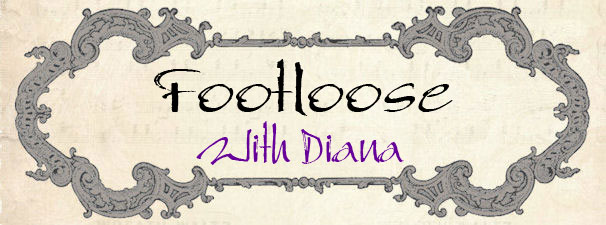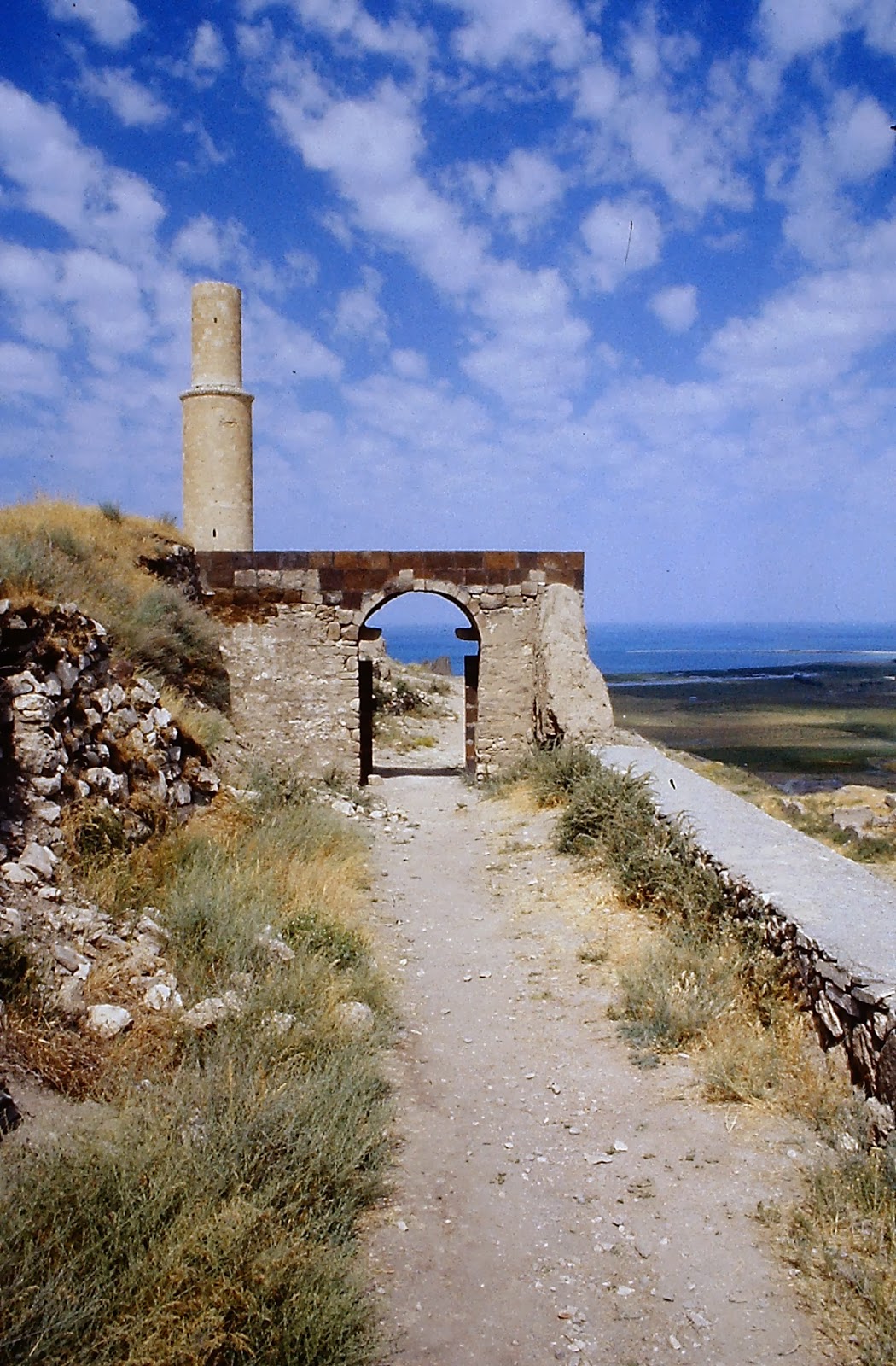From Doğubeyazıt, we drove to the town of Gürbulak, for some reason I can't recall as all I have is a photo of us in front of what I think is the telegraph office; anyway, we were en route to a huge meteor crater, within eyesight of the Iranian border (where you see the sign). Must be a very boring posting to patrol, so the border guard came over to take a look at us and chat with the guide:
The crater is supposed to be the second largest in the world. I was amused to see the sign said the largest is in Alaska, but having been raised in Arizona, I knew it's in Arizona, although I was unable to convince any of the functionaries there that their sign was incorrect. Well, we do have several states that start and end with "a," so I suppose confusion is understandable...
Of course, Mt. Ararat, 16,854 ft, is the main lure for tourists to this part of Turkey, and it is a stunner:
The massif is, as you can see very rocky and rugged:
A saline soda lake, Lake Van is the largest lake in Turkey, 74 miles across at its widest point, and averages about 560 feet in depth. Van Castle looms over the area. Built by the Urartu in the 9th to 7th centuries BC, it has been controlled by Armenians, Romans, Medes, Persians, Arabs, Selçuks, Ottomans, and Russians, to name a few. By virtue of its site, its 1.1 miles long, but only 160 feet wide at the widest point.
It was quite ruined when I was there, but there were several teams of archaeologists beavering away in 1990, so I imagine it's at least partially restored now:
This tower is on the narrowest point at one end of the Castle:
I was surprised (I don't know why) to find quite a lot of cuneiform writing carved into panels around the Castle. In fact, there is a famous cuneiform inscription near the castle by Xerxes the Great in a niche carved out by his father, King Darius, giving thanks to the Zoroastrian god Ahuramazda in the Old Persian, Babylonian and Elamite languages, and rather like the similar Rosetta Stone, it has made a significant contribution to scholars deciphering the Old Persian tongue. Tourists aren't allowed anywhere near it, so you'll have to be content with my own poor photo, I'm afraid:
Near Lake Van, at Gevaş, is a beautiful tomb of a Selçuk princess:
The main purpose most tourists have in visiting Van (other than buying carpets and gushing over the famous white Van cats, which are invariably deaf and whose eyes are each a different color) is to see the ruined 10th-century Armenian church on Akdamar Island in Lake Van. From the ferry to the island, you can see how blue the lake is (the church is just off center in the following photo):
The Church is exquisite:

The crater is supposed to be the second largest in the world. I was amused to see the sign said the largest is in Alaska, but having been raised in Arizona, I knew it's in Arizona, although I was unable to convince any of the functionaries there that their sign was incorrect. Well, we do have several states that start and end with "a," so I suppose confusion is understandable...
Of course, Mt. Ararat, 16,854 ft, is the main lure for tourists to this part of Turkey, and it is a stunner:
The massif is, as you can see very rocky and rugged:
A saline soda lake, Lake Van is the largest lake in Turkey, 74 miles across at its widest point, and averages about 560 feet in depth. Van Castle looms over the area. Built by the Urartu in the 9th to 7th centuries BC, it has been controlled by Armenians, Romans, Medes, Persians, Arabs, Selçuks, Ottomans, and Russians, to name a few. By virtue of its site, its 1.1 miles long, but only 160 feet wide at the widest point.
It was quite ruined when I was there, but there were several teams of archaeologists beavering away in 1990, so I imagine it's at least partially restored now:
This tower is on the narrowest point at one end of the Castle:
I was surprised (I don't know why) to find quite a lot of cuneiform writing carved into panels around the Castle. In fact, there is a famous cuneiform inscription near the castle by Xerxes the Great in a niche carved out by his father, King Darius, giving thanks to the Zoroastrian god Ahuramazda in the Old Persian, Babylonian and Elamite languages, and rather like the similar Rosetta Stone, it has made a significant contribution to scholars deciphering the Old Persian tongue. Tourists aren't allowed anywhere near it, so you'll have to be content with my own poor photo, I'm afraid:
Near Lake Van, at Gevaş, is a beautiful tomb of a Selçuk princess:
The main purpose most tourists have in visiting Van (other than buying carpets and gushing over the famous white Van cats, which are invariably deaf and whose eyes are each a different color) is to see the ruined 10th-century Armenian church on Akdamar Island in Lake Van. From the ferry to the island, you can see how blue the lake is (the church is just off center in the following photo):
The Church is exquisite:

It sports the most astonishing carvings on the exterior, featuring Biblical stories - this one clearly shows the story of David and Goliath:
This panel depicts the story of Jonah and the Whale on the left and the Garden of Eden on the right:
The two carvings above are shown to the left on this wider view of the wall and corner:
The interior was quite ruined when I was there in 1990, with the elements having pretty much erased the frescoes, unfortunately. I'm told the Church has now been restored by the Turkish government and that Armenians were permitted to come and hold a mass here recently. I think you can get a little bit of an idea of how magnificent the interior decoration was originally from these photos:
Scattered around the exterior of the church are some beautiful gravestones:
Gravestones, not coincidentally, are an appropriate way to end the photos of my 1990 tour of Turkey. I hope you enjoyed looking at both the old and the new, because it's a country I love; I'm so glad I've had the opportunity to visit it twice and see so much of what it has to offer.

























No comments:
Post a Comment